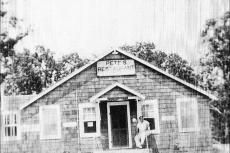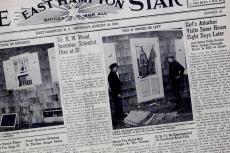125 Years Ago 1900
From The East Hampton Star, April 27
A decision affecting the rights of the Montauk tribe of Indians to property which they claim at the east end of Long Island has been handed down by the Court of Appeals. It is in the case of Eugene A. Johnson versus the Long Island Railroad. It was an appeal from an order of the Appellate Division, second department, reversing an interlocutory judgment which sustained a demurrer to the complaint.
The appeal is taken by permission of the Appellate Division, which certified three questions to this court: First, has the plaintiff in this action legal capacity to sue? Second, is there a defect of the parties plaintiff in this action, in that the members of the alleged Montauk tribe of Indians are not made parties plaintiff? Third, does the complaint herein state facts sufficient to constitute a cause of action?
It is conceded by the complaint in this action “that the tribe have no legal capacity to sue, therefore, and have no corporate name by which they can institute such a suit.”
—
Now is the time to use kerosene on fruit trees to get the best results, for it can only be applied in the requisite strength while the tree is dormant. It has been demonstrated that a mixture of seventy-five parts of kerosene and twenty-five parts water is a much better wash for fruit trees than whitewash. It is quickly absorbed, and spreads into crevices that can not be so well reached by any other insecticide.
100 Years Ago 1925
From The East Hampton Star, April 24
The John Doe investigation into charges of rum smuggling and “protective bribery” in Suffolk County was started before Justice of the Peace Robert Burnside at Riverhead on Monday. After half a dozen witnesses were heard, the investigating officers had before them considerable testimony that there has been no bootlegging, rum-running, or corruption of the Prohibition enforcement officials anywhere on Long Island.
This is in contradiction of reliable reports printed that Suffolk County has been the great gateway through which New York got a large part of its supplies from Rum Row, and that $500 a week had been paid to State Troopers and others for allowing the bottled beverages to go through unmolested.
It is likewise in contradiction of the facts revealed when a trooper and other hijackers raided the Benson estate near Montauk and found a cache of whiskey and champagne valued at $400,000.
—
The village board, at its regular semi-monthly meeting, went on record as adopting Daylight Saving, effective April 26 to September 27. This is in accordance with action made by other Long Island villages.
—
A petition signed by fourteen residents on Pantigo Lane was sent to the board requesting them to do all in their power to keep that section strictly a residential section. The reason for this petition is that Daniel Lester is going to erect a garage and gasoline supply station on his lot on Pantigo Lane.
75 Years Ago 1950
From The East Hampton Star, April 27
The early season rush of fishermen arriving at Montauk on Sunday took everyone by surprise, for not all of the fishing boats that are usually at that port had arrived for the season. The Long Island’s fishing excursion trains have not yet started running and many of the fishermen who had arrived by car — and early risers, too, for they leave Brooklyn, Astoria, and Manhattan to arrive at Montauk by 7 a.m. — were left on the dock.
Each year Montauk’s fame as a resort and fishing spot grows and they come from near and far for a day or a season’s outing at Montauk. Each succeeding week-end will see more and more visitors. For the fishermen there will be added facilities and plenty of boats for all comers.
—
For the second straight year, Governor Thomas E. Dewey has declined to permit provisions for “spot” zoning in eastern Suffolk County to be written into state law. State Senator S. Wentworth Horton’s bill, which had the endorsement of the County Board of Supervisors, was vetoed last Wednesday.
The Horton bill, which was sponsored in the lower house of the State Legislature by Assemblyman Edmund R. Lupton, would have amended the town law to make possible the zoning of unincorporated areas within Suffolk’s five unzoned towns through the formation of special districts.
50 Years Ago 1975
From The East Hampton Star, April 24
A “combination of two national tragedies,” Lyndon Johnson’s Defense Secretary reported in Southampton Friday night, had “so changed the attitude of our people” that “for the first time in our history people in this country have begun to lose faith in our government.” The Gold Crest Manor, a blandly monumental convention hall where local Republicans often rally, was thronged this time by several hundred slightly younger Democrats. The tragedies, said Clark Clifford, were Richard Nixon’s “misrule” and, “at the same time,” the Vietnam war.
Mr. Clifford was reputed to be a “superhawk” when President Johnson appointed him in 1968 to replace Robert McNamara, who was suspected of doubts if not dovishness, but he too had almost immediate second thoughts and has been credited with influencing the 1968 bombing halt.
—
Ten parcels of farmland in East Hampton Town, totaling 233.5 acres, have survived screening by a special County committee. They were submitted to the County Legislature Tuesday as likely sites for purchase of development rights under the County’s farmland acquisition program. Three parcels from East Hampton Town were rejected by the screening committee totaling 117.3 acres.
The screening committee, the Select Committee on the Acquisition of Farmlands, was created by County Executive John V.N. Klein, and charged with winnowing some $117 million in bids before their formal submission to the County Legislature.
25 Years Ago 2000
From The East Hampton Star, April 27
The long-simmering public stew over East Hampton Airport promises to heat up again on Friday, May 5, when the East Hampton Town Board holds public hearings on three separate airport-related matters.
After years of lawsuits and vocal community opposition to the airport, where jet traffic and related noise have increased since the main runway was repaved two years ago, the board voted in February 1999 to require a public hearing whenever the Federal Aviation Administration is being asked for money, and at every step along the way in updating the airport’s layout and master plan.
—
When an emergency service worker UpIsland became severely ill recently after handling a utility pole at an accident site, officials seeking the possible cause learned the pole had been treated with a chemical which, if not handled with caution, can be potentially fatal.
It appears there are many of the treated poles in East Hampton and Montauk, according to Bruce Bates, deputy coordinator of the East Hampton Town Emergency Preparedness Department and director of the town’s Hazardous Materials team. Mr. Bates sent a letter on April 12 to all East End fire departments and emergency service agencies alerting them to the situation.
Since 1995, it seems, the Osmose Wood Preserving Company has been treating wooden utility poles with methyl isothiocyanate, which contains a component of cyanide.



